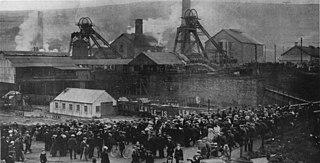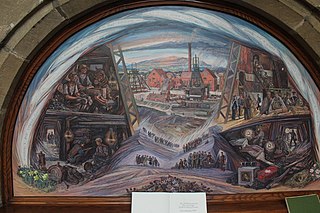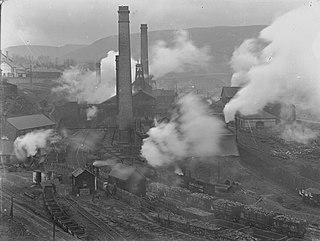Related Research Articles

South Wales is a loosely defined region of Wales bordered by England to the east and mid Wales to the north. Generally considered to include the historic counties of Glamorgan and Monmouthshire, south Wales extends westwards to include Carmarthenshire and Pembrokeshire. In the western extent, from Swansea westwards, local people would probably recognise that they lived in both south Wales and west Wales. The Brecon Beacons National Park covers about a third of south Wales, containing Pen y Fan, the highest British mountain south of Cadair Idris in Snowdonia.

Risca is a town in the Caerphilly County Borough and the historic boundaries of Monmouthshire in south-east Wales. Risca has a railway station, opened on the Ebbw Valley Railway in February 2008, after a gap of 46 years. It is split into two communities; Risca East and Risca West. It has a population of 11,700. The town is now part of the Cardiff Capital Region which has a combined population of 1,543,293. Cardiff the capital of Wales can be reached in under 28 minutes from the nearby railway station of Risca and Pontymister station which reopened in 2008 after a gap of nearly 60 years.
A mining accident is an accident that occurs during the process of mining minerals or metals. Thousands of miners die from mining accidents each year, especially from underground coal mining, although accidents also occur in hard rock mining. Coal mining is considered much more hazardous than hard rock mining due to flat-lying rock strata, generally incompetent rock, the presence of methane gas, and coal dust. Most of the deaths these days occur in developing countries, and rural parts of developed countries where safety measures are not practiced as fully. A mining disaster is an incident where there are five or more fatalities.

Big Pit National Coal Museum is an industrial heritage museum in Blaenavon, Torfaen, Wales. A working coal mine from 1880 to 1980, it was opened to the public in 1983 as a charitable trust called the Big Pit (Blaenavon) Trust. By 1 February 2001 Big Pit Coal Museum was incorporated into the National Museums and Galleries of Wales as the National Mining Museum of Wales. The site is dedicated to operational preservation of the Welsh heritage of coal mining, which took place during the Industrial Revolution.

The South Wales Coalfield extends across Pembrokeshire, Carmarthenshire, Swansea, Neath Port Talbot, Bridgend, Rhondda Cynon Taf, Merthyr Tydfil, Caerphilly, Blaenau Gwent and Torfaen. It is rich in coal deposits, especially in the South Wales Valleys.

The Senghenydd colliery disaster, also known as the Senghenydd explosion, occurred at the Universal Colliery in Senghenydd, near Caerphilly, Glamorgan, Wales, on 14 October 1913. The explosion, which killed 439 miners and a rescuer, is the worst mining accident in the United Kingdom. Universal Colliery, on the South Wales Coalfield, extracted steam coal, which was much in demand. Some of the region's coal seams contained high quantities of firedamp, a highly explosive gas consisting of methane and hydrogen.

The Gresford disaster occurred on 22 September 1934 at Gresford Colliery, near Wrexham, Denbighshire, when an explosion and underground fire killed 266 men. Gresford is one of Britain's worst coal mining disasters: a controversial inquiry into the disaster did not conclusively identify a cause, though evidence suggested that failures in safety procedures and poor mine management were contributory factors. Further public controversy was caused by the decision to seal the colliery's damaged sections permanently, meaning that only eleven of those who died were recovered.
Albion Colliery was a coal mine in South Wales Valleys, located in the village of Cilfynydd, one mile north of Pontypridd.

Gresford Colliery was a coal mine located a mile from the North Wales village of Gresford, near Wrexham.

Six Bells Colliery was a colliery located in Six Bells, Abertillery, Gwent, Wales. On 28 June 1960 it was the site of an underground explosion which killed 45 of the 48 miners working in that part of the mine. It is now the site of the artistically acclaimed Guardian memorial to those events, designed by Sebastian Boyesen; although the memorial primarily commemorates those who died at Six Bells, it is dedicated to all mining communities wherever they may be.
The Tarenni Colliery and its associated workings, are a series of coal mines and pits located between the villages of Godre'r Graig and Cilybebyll located in the valley of the River Tawe, in Neath Port Talbot county borough, South Wales.

Deep Navigation Colliery was a coal mine in South Wales, that operated from 1872 until 1991.

Crosskeys is a village, community and an electoral ward in Caerphilly county borough in Wales.
John Russell was a British coal and iron master, who had extensive industrial interests especially in the South Wales valleys in the mid-nineteenth century. He was High Sheriff of Monmouthshire in 1855.
The Peckfield pit disaster was a mining accident at the Peckfield Colliery in Micklefield, West Yorkshire, England, which occurred on Thursday 30 April 1896, killing 63 men and boys out of 105 who were in the pit, plus 19 out of 23 pit ponies.

The Lundhill Colliery explosion was a coal mining accident which took place on 19 February 1857 in Wombwell, Yorkshire, UK in which 189 men and boys aged between 10 and 59 died. It is one of the biggest industrial disasters in the country's history and it was caused by a firedamp explosion. It was the first disaster to appear on the front page of the Illustrated London News.
The Sneyd Colliery Disaster was a coal mining accident on 1 January 1942 in Burslem in the English city of Stoke-on-Trent. An underground explosion occurred at 7:50 am, caused by sparks from wagons underground igniting coal dust. A total of 57 men and boys died.
Morgan Morgans (1814–1888) was a civil engineer particularly involved with mining.

The Cymmer Colliery explosion occurred in the early morning of 15 July 1856 at the Old Pit mine of the Cymmer Colliery near Porth, Wales, operated by George Insole & Son. The underground gas explosion resulted in a "sacrifice of human life to an extent unparalleled in the history of coal mining of this country" in which 114 men and boys were killed. Thirty-five widows, ninety-two children, and other dependent relatives were left with no immediate means of support.
References
- 1 2 "Black Vein Colliery". Welsh Coal Mines. Retrieved 16 September 2016.
- 1 2 "Risca New Pit". Welsh Coal Mines. Retrieved 16 September 2016.
- 1 2 Jones, Alan Victor (1980). Risca - its industrial and social development. Bognor Regis: New Horizon. ISBN 0-86116-472-5.
- ↑ Lovering, G.W.J. (Autumn 1995). "A View of the County, c.1850". Gwent Local History. Gwent Local History Council (79): 2–24. ISSN 0308-0374 . Retrieved 26 March 2018– via Welsh Journals.
- ↑ Reports from Commissioners: Gases and Explosions in Collieries. 1847. pp. 29–39.
- ↑ "Black Vein Death Rolls". Welsh Coal Mines. Retrieved 16 September 2016.
- ↑ "Tremendous Colliery Explosion". The Welshman . 1846-01-23. hdl: 10107/4364654 – via Welsh Newspapers.
- ↑ "The late Fatal Explosion at Risca". Monmouthshire Merlin . 7 February 1846. hdl: 10107/3425253 – via Welsh Newspapers.
- ↑ Lovering, G.W.J. (Spring 1996). "Herbert Francis Mackworth and the Coal Industry in Monmouthshire, 1851-1858". Gwent Local History. Gwent Local History Council (80): 21–30. ISSN 0308-0374 . Retrieved 26 March 2018– via Welsh Journals.
- 1 2 3 "The Late Colliery Explosion at Risca". The Cardiff and Merthyr Guardian Glamorgan Monmouth and Brecon Gazette. 1846-01-24. hdl: 10107/3088621 – via Welsh Newspapers.
- 1 2 3 4 5 Owen, David (2005). South Wales collieries / Mining disasters. Tempus. ISBN 0-7524-3564-7.
- ↑ "Fatal Colliery Explosion". The Cardiff and Merthyr Guardian Glamorgan Monmouth and Brecon Gazette. 1853-03-19. hdl: 10107/3090483 – via Welsh Newspapers.
- ↑ "Colliery Explosion at Risca". Monmouthshire Merlin . 1 April 1853. p. 5. hdl: 10107/3395622 – via Welsh Newspapers.